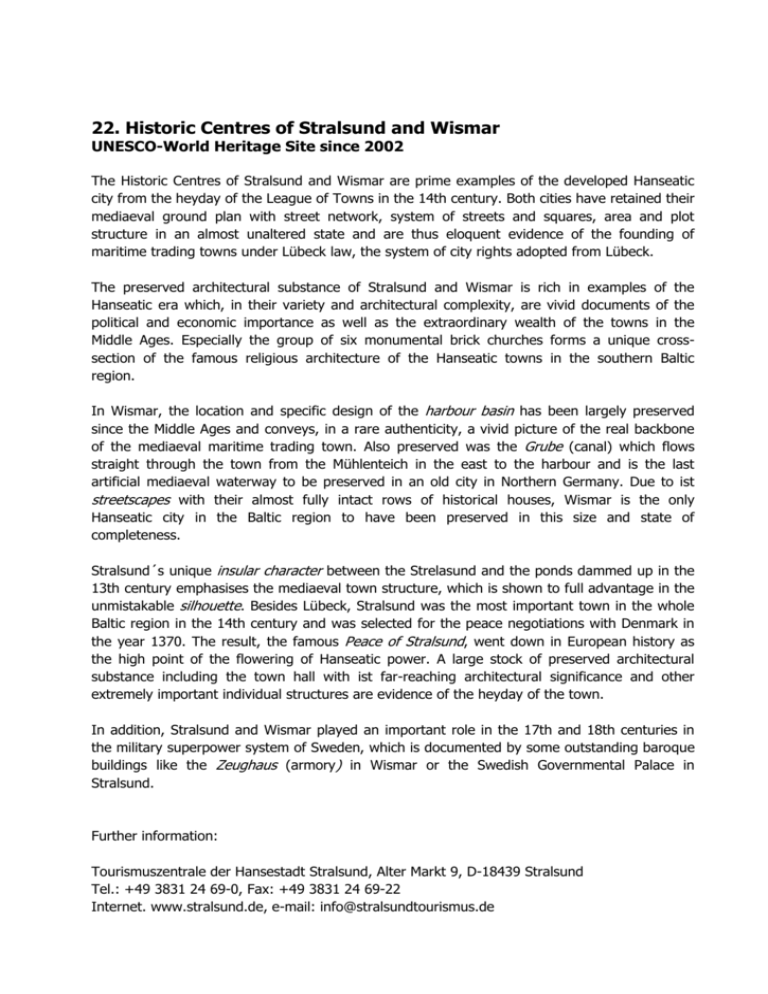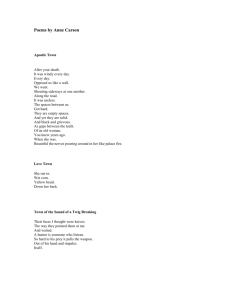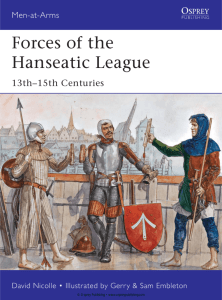22. Historic Centres of Stralsund and Wismar
advertisement

22. Historic Centres of Stralsund and Wismar UNESCO-World Heritage Site since 2002 The Historic Centres of Stralsund and Wismar are prime examples of the developed Hanseatic city from the heyday of the League of Towns in the 14th century. Both cities have retained their mediaeval ground plan with street network, system of streets and squares, area and plot structure in an almost unaltered state and are thus eloquent evidence of the founding of maritime trading towns under Lübeck law, the system of city rights adopted from Lübeck. The preserved architectural substance of Stralsund and Wismar is rich in examples of the Hanseatic era which, in their variety and architectural complexity, are vivid documents of the political and economic importance as well as the extraordinary wealth of the towns in the Middle Ages. Especially the group of six monumental brick churches forms a unique crosssection of the famous religious architecture of the Hanseatic towns in the southern Baltic region. In Wismar, the location and specific design of the harbour basin has been largely preserved since the Middle Ages and conveys, in a rare authenticity, a vivid picture of the real backbone of the mediaeval maritime trading town. Also preserved was the Grube (canal) which flows straight through the town from the Mühlenteich in the east to the harbour and is the last artificial mediaeval waterway to be preserved in an old city in Northern Germany. Due to ist streetscapes with their almost fully intact rows of historical houses, Wismar is the only Hanseatic city in the Baltic region to have been preserved in this size and state of completeness. Stralsund´s unique insular character between the Strelasund and the ponds dammed up in the 13th century emphasises the mediaeval town structure, which is shown to full advantage in the unmistakable silhouette. Besides Lübeck, Stralsund was the most important town in the whole Baltic region in the 14th century and was selected for the peace negotiations with Denmark in the year 1370. The result, the famous Peace of Stralsund, went down in European history as the high point of the flowering of Hanseatic power. A large stock of preserved architectural substance including the town hall with ist far-reaching architectural significance and other extremely important individual structures are evidence of the heyday of the town. In addition, Stralsund and Wismar played an important role in the 17th and 18th centuries in the military superpower system of Sweden, which is documented by some outstanding baroque buildings like the Zeughaus (armory) in Wismar or the Swedish Governmental Palace in Stralsund. Further information: Tourismuszentrale der Hansestadt Stralsund, Alter Markt 9, D-18439 Stralsund Tel.: +49 3831 24 69-0, Fax: +49 3831 24 69-22 Internet. www.stralsund.de, e-mail: info@stralsundtourismus.de Tourist-Information Wismar, Am Markt 11, D-23966 Wismar Tel.: +49 3841 2 51-30 25, Fax: +49 3841 2 51-30 91 Internet: www.wismar.de, e-mail: touristinfo@wismar.de







